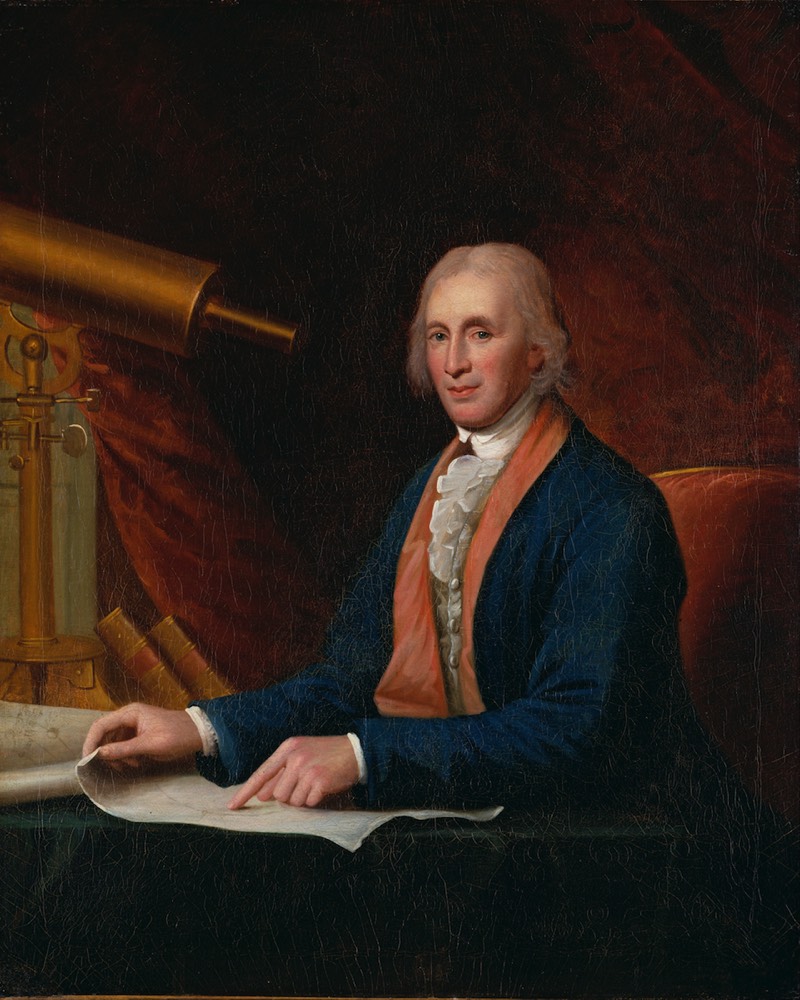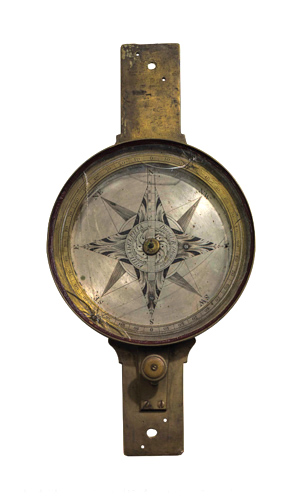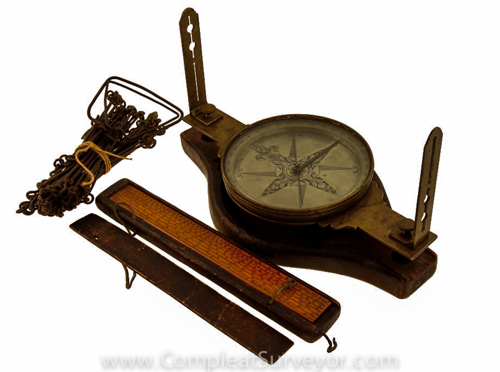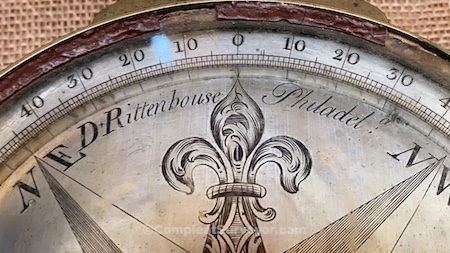David Rittenhouse

David Rittenhouse - Creative Genius
David Rittenhouse - The Surveying Related Career
David Rittenhouse made topographic surveys for roads and rivers, and he likely performed property surveys as well. He was the City Surveyor of Philadelphia for part of 1774. The most significant and widely known of his field work dealt with laying out boundaries between states. This work typically involved the ranging of lines of either latitude or longitude, according to positions determined from his astronomical observations.
Rittenhouse worked on jurisdictional lines involving Delaware, Massachusetts, New Jersey, New York, Ohio, Pennsylvania, and Virginia. He helped run the 90-mile westward extension of the Mason-Dixon line and set the southwest corner of Pennsylvania. From this location, a party of four commissioners including David Rittenhouse, Andrew Ellicott, and General Andrew Porter, together with 30 men, ran north in 1785 to set the Pennsylvania-Virginia boundary. Along the way, they set a post on the north bank of the Ohio River. That marker, described in the journal of General Richard Butler as "the post set up by Mr. Rittenhouse," was adopted later that year by Thomas Hutchins as the Initial Point for the survey of the Seven Ranges (Butler, 1847; Porter, 1880). The Rittenhouse post thus became the starting point for subdividing the public lands of the United States under the Land Ordinance of 1785.
Several of the instruments made by David Rittenhouse show mechanical ingenuity. Some are artistically decorated, others not. He is generally credited as the inventor of the vernier compass, but there is no clear record of this. It has been suggested that the design may have originated in Europe, and Rittenhouse may instead have introduced it in America.
He began making clocks while in his teens, and probably began making instruments in the late 1760's. It is not known from whom he learned to make these instruments, but the task would not have been difficult for one so mechanically inclined. Although he must have studied actual instruments, he probably gained important knowledge from published works. On February 21, 1767 Thomas Barton wrote to Rittenhouse, encouraging his brother-in-law to build an orrery, and urging him to purchase N. Bion's well-illustrated and informative book: The Construction and Principal Uses of Mathematical Instruments, translated by Edmund Stone (Rice, 1954). The fact that Rittenhouse built an azimuth compass mounted in a wood base, quite like the one pictured by Stone, suggests that he did in fact have access to the book (Smart, 1962). So does the fact that Bion explains how to divide a circle into one-degree increments, the usual graduation found in Rittenhouse compasses.
The Revolutionary War interrupted Rittenhouse's manufacturing, and afterward he engaged in other activities, including state boundary surveying. Nonetheless, in 1780 he sought good optical glass for grinding telescope lenses, and reportedly produced surveying instruments into the 1780's.
David Rittenhouse probably produced less than two dozen surveying instruments, and less than seventy-five clocks (Eckhardt, 1955). By way of comparison, Thomas Whitney advertised in 1820 that he had produced about 500 surveying compasses during the preceding thirteen years.
Rittenhouse did not have a consistent instrument signature. His instruments appear to be the work of several hands, suggesting apprentices or assistants. The engraved letters and numbers vary in quality, even on the same instrument. Some of David's instruments are absent of decoration. Some instruments are likely to have received more of Rittenhouse's personal labor than others. Those include the compasses with special devices like the rotating dial, vernier, solar device, and automatic needle lifter.
DR1 - David made this compass when he lived in Norriton, before he moved to Philadelphia. Note the dovetail attaching system for the sight vanes - and early type attaching system. Beautiful compass held by the Historical Society of Pennsylvania. Pic is from my dad's article.
DR2 - Wonderfully engraved vernier compass missing its sight vanes. The engraving looks different on the signature part - less skillful, but its hard to tell. Click here for a write-up on the compass. Held by the Natural Museum of American History in Washington DC.
DR3 - This is a very special compass (I wish I owned it). This is a vernier - variation compass with wonderful engraving. Purchased at a Christies auction for $37.5k, and worth every penny in my opinion. Christies did a lousy job of describing this compass - the pics don't show the solar apparatus. This compass, and DR4 below, show the true genius of David Rittenhouse. I discuss DR3 and DR4 below in the My Thoughts section.
DR4 - Like DR3 above, this is a VERY special compass . This compass, and DR3 above, show the true genius of David Rittenhouse. This is a vernier - variation compass with very little engraving. Probably DR's first attempt at making the vernier - variation compass. I discuss DR3 and DR7 below in the My Thoughts section. Held by the NY State Museum. And, by the way, George Washington apparently once owned this instrument .
DR5 - David made this compass when he lived in Norriton, before he moved to Philadelphia. Looks similar to DR1, but note that DR used thumbscrews to attach the sight vanes. Probably made after DR1. Not sure who owns this compass, but I found it here.
DR6 - I don't know much about this compass. Skinner sold the compass in 2006 for nearly $20k. Looks beautiful, but Skinner only has very small pics on its website,
DR7 - David made this 21 inch level after he moved to Philadelphia. Rather plain in appearance. Held by the Historical Society of Montgomery County, PA. Pic is from my dad's article.
DR8 - A Plain Compass David made while in Philadelphia. Very nice compass - sold for $27,000 plus 20% buyers fee ($32,400 in total) in late 2021. See a few more pics: Pic#1 - Pic#2
David Rittenhouse Compasses - My Thoughts
David Rittenhouse Compasses are VERY rare and valuable. The fame of DR had faded over the years - many people and collectors have never heard of him. When I explain who DR was, I merely state that he was a genius, and that he was the second President of the most famous Colonial Scientific Society. The first President was Ben Franklin and the third President was Thomas Jefferson. Those are some serious credentials.
David was a practicing surveyor for a number of years, so he looked at problems from a practical as well as a theoretical perspective. DR did not make very many instruments, my dad thought maybe two dozen. But the handful of surviving instruments evidence a surveyor's practical understanding of problems AND a creative genius for finding solutions to these problems.
Take DR2 for example, which looks like a plain compass but is actually a vernier compass as you can see from the Natural Museum of American History in Washington DC website. While DR likely was not the first to put a vernier on a compass, he very likely came up with the idea on his own and was almost definitely the first to put a vernier on a compass in America. DR2 is the only Rittenhouse compass with a bottom side vernier system, so it's clear that DER testing different ways to build a vernier mechanism.
But DR3 and DR4 show the true genius of David Rittenhouse. Those are both vernier - variation compasses. You can read my dad's 1994 published write up on DR4 here. DR3 and DR4 were way ahead of their time. Reverse engineering what the compasses were and what they could do was not an easy matter, especially because DR's approach was so novel. I view these two instruments to be among the most valuable surveying instruments ever made. DR only made two of these special instruments, and one of them was used by George Washington.
DR was also the main driver of the "Rittenhouse" branded compasses. So I have more DR related thoughts on that webpage as well.
Rittenhouse Articles
Bud Uzes authored two articles in the early 1990s regarding Rittenhouse surveying instruments. Bud's files included a fair number of background reference materials, and I've found a few additional articles published in the last 20 years that are relevant to collecting surveying instruments made by the Rittenhouse Family. Attached below are the most helpful articles. Please keep in mind that collectors were trying to figure this stuff out, and that developments may have impacted some of the analysis and conclusions stated in the articles. I've also included a longer list of my dad's reference materials.
1. Uzes - Colonial Surveyor and Instrument Maker (1990) published in the Rittenhouse Journal (Vol 5, No 1).
2. Uzes - The Brothers Rittenhouse - 1994 ACSM Presentation (similar to the Rittenhouse Journal Article)
3. Bedini - David Rittenhouse (1732-1796) - Rittenhouse Journal (Vol 14, No 1).
4. Bedini - Benjamin Rittenhouse (1740-1825)
5. Bedini - Benjamin Rittenhouse and His Apprentices and Partners
6. Bedini - Relevant Pages from Thinkers and Tinkerers
7. Lock - David Rittenhouse Telescopic Theodolite - The American Surveyor (Dec 2007)
8. Forman - The Worcester Workshop of Benjamin Rittenhouse
9. Smart - The Makers of Surveying Instruments in America Since 1700 (Relevant Pages)
10. Other List of References Pulled Together by Bud Uzes
© 2020 Russ Uzes/Contact Me







